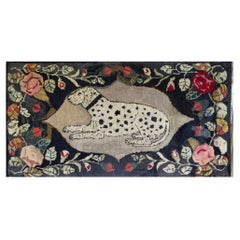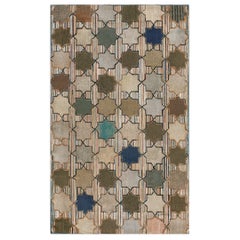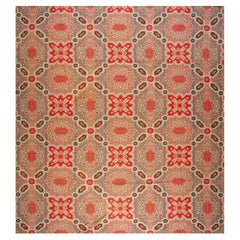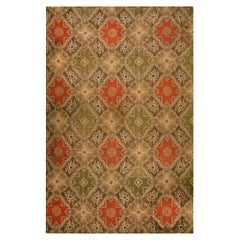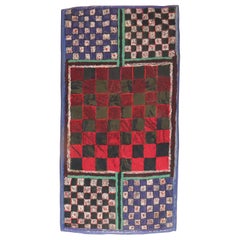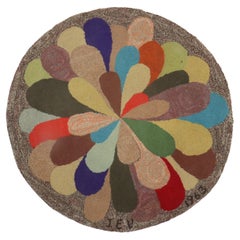1850s North and South American Rugs
to
Width
to
Length
to
4
2
5
193
1,427
868
669
547
144
70
73
281
190
70
47
37
34
14
16
4
4
1
1
4
4
4
4
3
3
Period: 1850s
American 19th Century Hooked Rug Depicting a Dalmatian
Located in Hudson, NY
Hooked and shirred hearth rug, New England, circa 1850s in wool, cotton and linen. This dramatic folk art piece is in excellent condition.
Depicting a recu...
Category
Folk Art Antique 1850s North and South American Rugs
Materials
Wool, Cotton, Linen
19th Century American Hooked Rug ( 4'6" x 7' - 137 x 213 )
Located in New York, NY
19th Century American Hooked Rug ( 4'6" x 7' - 137 x 213 )
Category
American Folk Art Antique 1850s North and South American Rugs
Materials
Wool
Mid 19th Century American Ingrain Carpet ( 12' 6" x 13' 4" - 381 x 406 cm )
Located in New York, NY
Mid 19th Century American Ingrain Carpet ( 12' 6" x 13' 4" - 381 x 406 cm )
Category
American Antique 1850s North and South American Rugs
Materials
Wool
Mid 19th Century American Ingrain Carpet ( 8' 2'' x 12' 9'' - 250 x 390 cm )
Located in New York, NY
Mid 19th Century American Ingrain Carpet ( 8' 2'' x 12' 9'' - 250 x 390 cm )
Category
American Antique 1850s North and South American Rugs
Materials
Wool
Related Items
American Hooked Checkerboard Chess Rug
Located in New York, NY
A handmade one of a kind American Hooked Rug from the 3rd quarter of the 20th century with an irregular checkerboard pattern
Measures: 3' x 5'7''.
Category
Mid-Century Modern 1850s North and South American Rugs
Materials
Wool
Round American Hooked Rug Dated 1963
Located in New York, NY
Rare American Hooked rug with a happy colorful motif. Dated 1963 and initialized IEV. Not sure whose name is in the initials
Measure: 30'' round.
Category
American Mid-Century Modern Vintage 1850s North and South American Rugs
Materials
Wool
Native American Hooked Rug
Located in New York, NY
A handmade American hooked rug from the mid-20th century depicting a head of a Native American on a brown field. Condition is really nice. No stains, no tears, has been professionall...
Category
American Country 1850s North and South American Rugs
Materials
Fabric, Wool, Jute
Early American Hand Hooked Rug
Located in Barrington, IL
This charming early American hand-hooked rug was crafted in the early 1900s in the New England region of the United States. Featuring a classic floral design, the rug displays blossoms in brilliant vintage tones, radiating warmth, character, and nostalgic beauty.
Antique hooked rugs are celebrated for their unique blend of folk art creativity and unpretentious simplicity. This piece is a wonderful example—both artistic and heartfelt—showcasing the resourcefulness and imaginative spirit of its maker. Created from repurposed materials and hand-dyed wool, it reflects a tradition where everyday utility met artistic expression.
A delightful and authentic piece of Americana, ideal for collectors of folk art or anyone drawn to the beauty of handmade heritage.
Dimensions: 2’ 1” x 3’ 4”
Date of Manufacture: Early 1900s
Place of Origin: America
Material: Wool and cotton pile on a burlap foundation
Condition: Wear consistent with age and use
The Persian Knot, SKU 1451
American Hooked Rugs, Vintage Hooked Rugs, Early American Hooked Rugs, American Rag Rugs, Antique Rug, Antique Rugs, Antique Carpets, Vintage Carpets, Handwoven Rugs, Vintage Artisan Rugs, Antique Handmade Rugs, Sustainability, Vintage Distressed Rugs, Allover Design Rug, Mid Century Modern Rugs, Vintage Rag Rugs, Vintage Wool Rag Rugs...
Category
American Antique 1850s North and South American Rugs
Materials
Wool, Cotton
19th Century Hand Hooked Folky Floral Rug Mounted with Braided Border
Located in Los Angeles, CA
This amazing hand hooked mounted rug with multi braided borders is 19th century and in very good condition. This fantastic work of art comes from Ex Stephen Score Antiques Inc. colle...
Category
American Country Antique 1850s North and South American Rugs
Materials
Wool
$1,516 Sale Price
20% Off
W 37 in L 33 in
60" 19th Century American Hooked Rug Framed
Located in Water Mill, NY
Monumental 19th American hooked rug mounted as a wall hanging.
Category
American Antique 1850s North and South American Rugs
Mid-20th Century Handmade American Braided Round / Circular Accent Carpet
Located in New York, NY
A vintage American Braid round/circular accent rug handmade during the mid-20th century.
Measures: 7' 1" x 7' 1".
Category
American American Classical 1850s North and South American Rugs
Materials
Wool, Yarn
Zabihi Collection American Hooked Accent Rug
Located in New York, NY
An accent size mid-20th-century American Hooked Rug
Details
rug no. j4218
size 4' 3" x 5' 7" (130 x 170 cm)
Category
American Country 1850s North and South American Rugs
Materials
Jute
Zabihi Collection American Hooked Duck Rug
Located in New York, NY
A handmade mini-size American hooked rug from the middle of the 20th century showing a duck
Measures: 2' x 2'6''.
Category
American Country 1850s North and South American Rugs
Materials
Wool, Jute
Saltillo Serape Mexican Blanket, 19th Century
Located in Istanbul, TR
A Saltillo serape is a type of Mexican blanket that originated in Saltillo, a city in the northern state of Coahuila. It is typically made of wool and features vibrant colors and intricate designs, often incorporating geometric shapes and floral motifs. The Saltillo serape is a popular item in Mexican culture...
Category
Mexican American Colonial Antique 1850s North and South American Rugs
Materials
Wool
Mid-20th Century Handmade American Rag Rug
Located in New York, NY
A vintage American rag rug handmade during the mid-20th century.
Measures: 3' 6" x 5' 8"
North American rugs & carpets:
North American has never developed a unified handmade rug tradition, but rather it is the unassimilated confluence of several. From Mexico comes the Saltillo serape wearing blanket, and this stimulates the Navajo and Rio Grande (Colorado) weavers, first as blankets, then as rugs. The thrifty habits of rural America gave rise to the New England (and Western Canadian) hooked rug types, while the farmers of the Midwest recycled their disused garments into braided and rag rugs.
The closest to a real ongoing tradition are the Southwestern (New Mexican) Navajo rugs. By the 1860s the native tribes were weaving wearing blankets with wool from the Spanish churro sheep. These were in stripe design, with combinations of undyed wool with cochineal reds and indigo blues. The multi-phase “Chief’s Blankets” from the 1870s-80s are a natural outgrowth of these. Machine spun red wool from Germantown in Pennsylvania appeared in the 1870s with a bright red hitherto unobtainable. The weavers loved it and blankets appeared with bright reds, generally aniline, in “eye dazzler” patterns. Anglo traders established posts beginning in the 1890s. Navajo weavings were perfect accompaniments not only for Western-themed decors, but for East Coast apartments, only they needed to be thicker and more rug like to be truly accepted. The traders brought Caucasian and Turkish village rugs to copy, borders were introduced and central medallions devised. The weavers continued to create on vertical looms, with a shared warp (dovetailing) weft structure to avoid slits. The warps were cotton string. Sizes were generally scatters, but occasionally a special order came in, hence antique room size Navajos are very rare and very pricey. Distinct village/pueblo styles developed. Among the best are: Two Grey Hills (considered the tightest, closest of all Navajo weaving), Crystal Springs, and Ganado. Certain new patterns such as the “Storm pattern” with jagged lightning bolts emanating from a dark cloud developed. The Yei rug with dancing Kachina doll figures became popular. The palette has been expanded beyond the classic grey, tan, dark brown, and cream natural wool combination to again include reds, blues, and greens. Navajo pictorials include American flags, trains, and automobiles, domestic and local scenes and scenery. Individual artist weavers now command gallery shows and correspondingly elevated prices. There are several levels of Navajo work, and antique and vintage scatters with simple flat designs, medium weaves, and tritonal palettes, and in good floor worthy condition are still available reasonably.
The Native American weaving tradition extends into Colorado with two-piece scatters with sharp sawtooth medallions and striped end borders, with wool tapestry weave on cotton warps. These descend from the Saltillo blankets...
Category
American Folk Art 1850s North and South American Rugs
Materials
Wool, Cotton, Yarn
Vintage American Pictorial Hooked Mat Size Rug
Located in New York, NY
American hooked rug from the late 20th century. An array of fruits and on circular medallions. A rooster spotted on one of the medallions. Initials of weaver found on another medallion.
Category
American Folk Art 1850s North and South American Rugs
Materials
Wool
